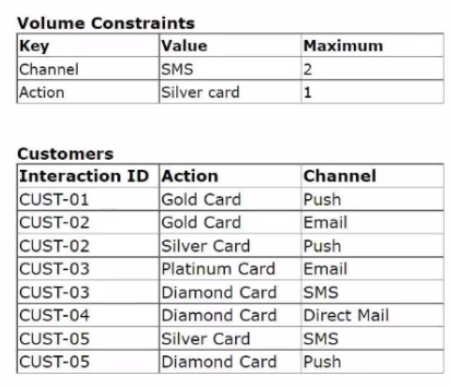Pegasystems PEGACPDC88V1 Exam Questions
- Topic 1: Define the starting population/ Optimize the customer value in the contact center
- Topic 2: Avoid overexposure of actions on outbound/ Limit action volume on outbound
- Topic 3: Create a real-time container/ Share action details with third-party distributors
- Topic 4: Implementing business changes using Revision Manager/ Agility in a customer engagement project
- Topic 5: Action prioritization with AI/ Create eligibility rules using customer risk segments
- Topic 6: Business agility in 1:1 customer engagement/ Building your business operations team
- Topic 7: Create engagement strategies using customer credit score/ Prioritize actions with business levers
- Topic 8: Define customer engagement policies/ Create and understand decision strategies
- Topic 9: Define and manage customer actions/ Contact policy and volume constraints
- Topic 10: Define an action for outbound/ Present a single offer on the web
- Topic 11: Create an engagement strategy/ Essentials of always-on outbound
Free Pegasystems PEGACPDC88V1 Exam Actual Questions
Note: Premium Questions for PEGACPDC88V1 were last updated On Jun. 25, 2025 (see below)
Pega Customer Decision Hub enables organizations to make Next-Best decisions. To which type of a decision is Next-Best-Action applied?
Next-Best-Action is a type of decision that involves selecting and prioritizing the most appropriate proposition for each customer at any given moment. Next-Best-Action can be applied to decisions that require customer-centricity, personalization, and contextualization. Determining if a borrower gets a loan is an example of such a decision, as it depends on the customer's attributes, behaviors, preferences, and needs. The other options are examples of decisions that are not related to customer interactions, but rather to operational or analytical processes. Verified Reference: [Pega Decisioning Consultant | Pega Academy]
A volume constraint uses the Return any action that does not exceed
constraint mode. The following tables show the configuration of the volume constraints and the list of customers in the outbound segment:

The outbound run selects customers in the following order to apply the volume constraints: CUST-01, CUST-02, CUST-03, and CUST-05.
Based on the configuration of the volume constraints for each channel, which offer does CUST-05 receive?
Pega Customer Decision Hub enables organizations to make Next-Best decisions. To which type of a decision is Next-Best-Action applied?
Next-Best-Action is a type of decision that involves selecting and prioritizing the most appropriate proposition for each customer at any given moment. Next-Best-Action can be applied to decisions that require customer-centricity, personalization, and contextualization. Determining if a borrower gets a loan is an example of such a decision, as it depends on the customer's attributes, behaviors, preferences, and needs. The other options are examples of decisions that are not related to customer interactions, but rather to operational or analytical processes. Verified Reference: [Pega Decisioning Consultant | Pega Academy]
In a decision strategy, to use a customer property in an expression, you
In a decision strategy, to use a customer property in an expression, you need to define Customer page in Pages & Classes and specify its class as Data-Customer. This allows you to access customer properties by using dot notation, such as Customer.Age or Customer.Gender. You do not need to define the property as a strategy property, use it without any prefix, or prefix it with the keyword Customer. Verified Reference: [Certified Pega Decisioning Consultant | Pega Academy], Decision strategies
Pega Customer Decision Hub enables organizations to make Next-Best decisions. To which type of a decision is Next-Best-Action applied?
Next-Best-Action is a type of decision that involves selecting and prioritizing the most appropriate proposition for each customer at any given moment. Next-Best-Action can be applied to decisions that require customer-centricity, personalization, and contextualization. Determining if a borrower gets a loan is an example of such a decision, as it depends on the customer's attributes, behaviors, preferences, and needs. The other options are examples of decisions that are not related to customer interactions, but rather to operational or analytical processes. Verified Reference: [Pega Decisioning Consultant | Pega Academy]
- Select Question Types you want
- Set your Desired Pass Percentage
- Allocate Time (Hours : Minutes)
- Create Multiple Practice tests with Limited Questions
- Customer Support
Alexia
7 days agoTanesha
12 days agoMalinda
2 months agoThad
2 months agoDaniel
3 months agoSanda
3 months agoTheodora
4 months agoRicki
4 months agoXuan
4 months agoDelisa
4 months agoVallie
5 months agoMelvin
5 months agoVallie
5 months agoChauncey
5 months agoFelix
6 months agoHeike
6 months agoDaren
6 months agoMeaghan
6 months agoJaime
7 months agoCandra
7 months agoTawny
7 months agoTran
7 months agoIlene
7 months agoChrista
8 months agoBeata
8 months agoPatrick
8 months agoJohnna
8 months agoJerrod
9 months agoMertie
9 months agoLore
9 months agoRosendo
9 months agoSheldon
9 months agoBettye
10 months agoSharen
10 months agoCarri
10 months agoMelda
10 months agoJettie
11 months agoDulce
12 months agoJuan
1 years agoJohna
1 years agoCristy
1 years agoTaryn
1 years agoBilly
1 years agoTony
1 years ago